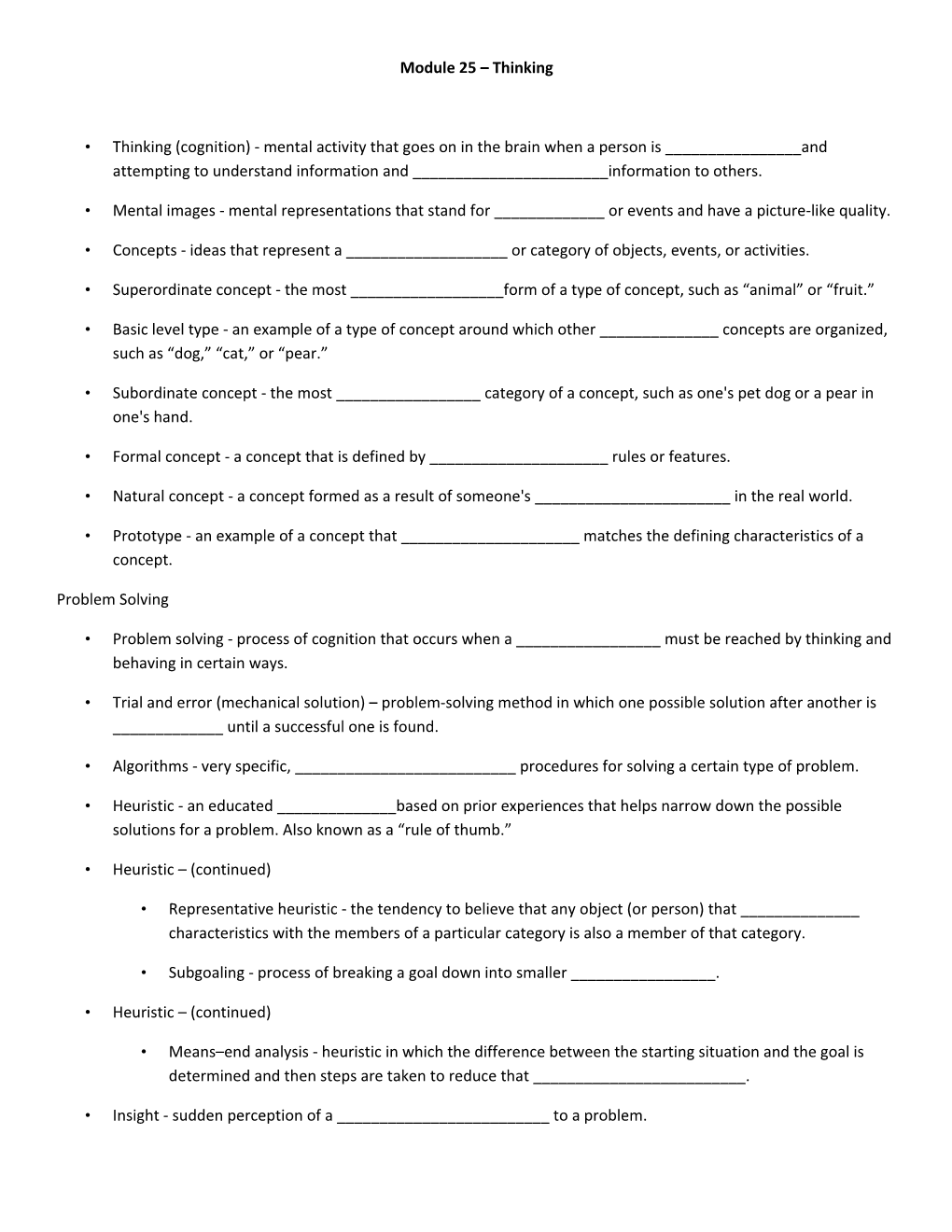Module 25 – Thinking
•Thinking (cognition) - mental activity that goes on in the brain when a person is ______and attempting to understand information and ______information to others.
•Mental images - mental representations that stand for ______or events and have a picture-like quality.
•Concepts - ideas that represent a ______or category of objects, events, or activities.
•Superordinate concept - the most ______form of a type of concept, such as “animal” or “fruit.”
•Basic level type - an example of a type of concept around which other ______concepts are organized, such as “dog,”“cat,” or “pear.”
•Subordinate concept - the most ______category of a concept, such as one's pet dog or a pear in one's hand.
•Formal concept - a concept that is defined by ______rules or features.
•Natural concept - a concept formed as a result of someone's ______in the real world.
•Prototype - an example of a concept that ______matches the defining characteristics of a concept.
Problem Solving
•Problem solving - process of cognition that occurs when a ______must be reached by thinking and behaving in certain ways.
•Trial and error (mechanical solution) – problem-solving method in which one possible solution after another is ______until a successful one is found.
•Algorithms - very specific, ______procedures for solving a certain type of problem.
•Heuristic - an educated ______based on prior experiences that helps narrow down the possible solutions for a problem. Also known as a “rule of thumb.”
•Heuristic – (continued)
•Representative heuristic - the tendency to believe that any object (or person) that ______characteristics with the members of a particular category is also a member of that category.
•Subgoaling - process of breaking a goal down into smaller ______.
•Heuristic – (continued)
•Means–end analysis - heuristic in which the difference between the starting situation and the goal is determined and then steps are taken to reduce that ______.
•Insight - sudden perception of a ______to a problem.
Artificial Intelligence
•Artificial intelligence (AI) - the creation of a ______that can think like a human.
•True flexibility of human thought processes has yet to be developed in a ______.
Problems to Solving Problems
•Functional fixedness - a block to problem solving that comes from thinking about objects in terms of only their ______functions.
•Mental set - the tendency for people to persist in using problem-solving ______that have worked for them in the past.
•Confirmation bias – the tendency to search for ______that fits one's beliefs while ______any evidence that does not fit those beliefs
Creativity
•Creativity - the process of solving problems by ______ideas or behavior in new ways.
–Convergent thinking - type of thinking in which a problem is seen as having only ______answer, and all lines of thinking will eventually lead to that single answer, using previous ______and logic.
•Creativity – (continued)
–Divergent thinking – type of thinking in which a person starts from one point and comes up with many ______ideas or possibilities based on that point (kind of creativity).
Mental Shortcuts – obstacles to making good judgements
•Conjunction fallacy - the error of believing ______conditions are more probable than a single general one.
•Availability heuristic - the tendency to estimate the probability of a certain condition or event based on how many similar instances we can ______.
•Anchoring effect - the tendency to consider all of the ______available, even when it is ______.
Obstacles to making decisions
•Gambler's fallacy - the belief that the chance of something occurring depends on whether it has ______occurred.
•Loss aversion - the tendency to be more sensitive to actual or potential ______than to gains.
